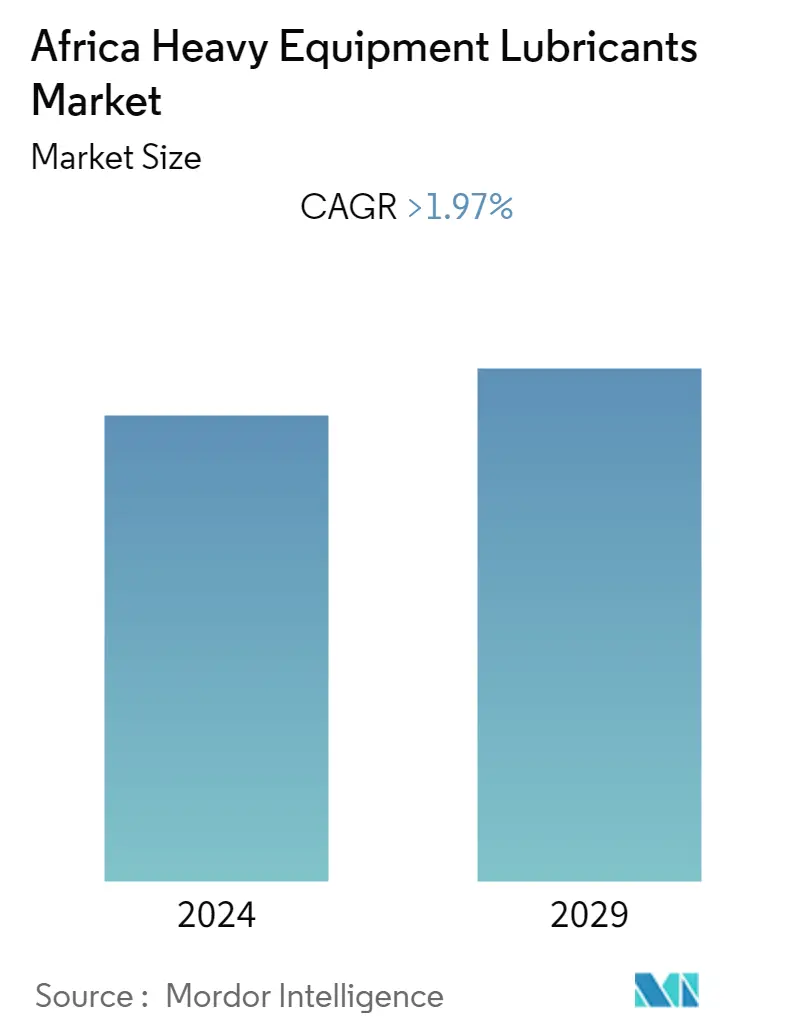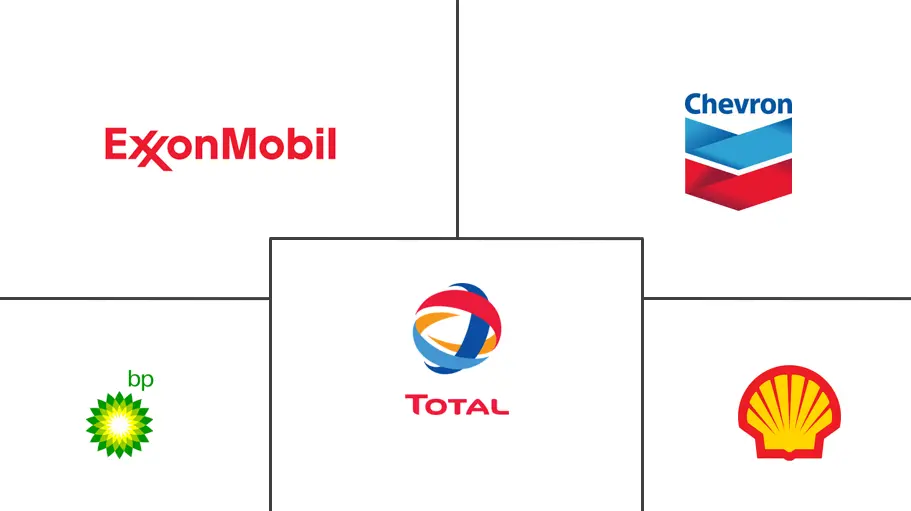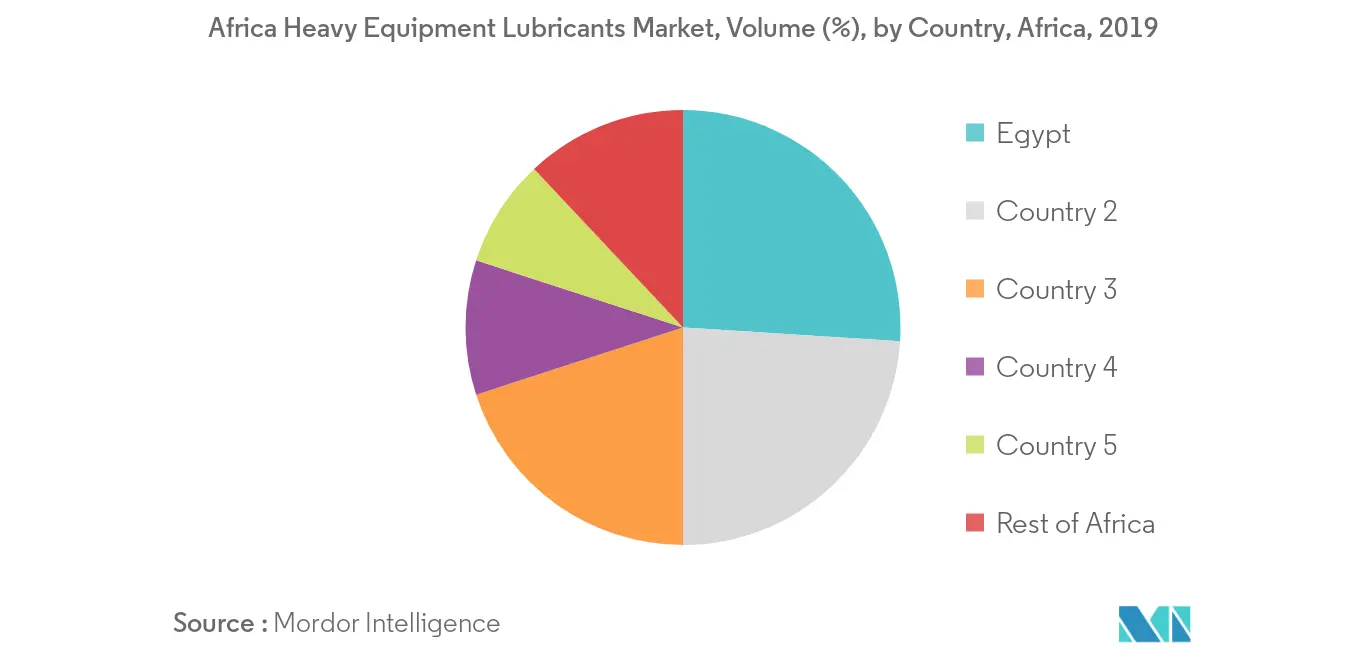Africa Heavy Equipment Lubricants Market Size

| Study Period | 2019 - 2029 |
| Base Year For Estimation | 2023 |
| Forecast Data Period | 2024 - 2029 |
| Historical Data Period | 2019 - 2022 |
| CAGR | > 1.97 % |
| Market Concentration | High |
Major Players
*Disclaimer: Major Players sorted in no particular order |
Africa Heavy Equipment Lubricants Market Analysis
The market for Africa heavy equipment lubricants is expected to grow at a CAGR of more than 1.97% globally during the forecast period. The growing demand from the end-user industries has been driving the market growth.
- However, the lack of awareness about scheduled maintenance and the outbreak of COVID-19 disease across the globe is likely to hinder the growth of the studied market.
- Developments in synthetic and bio-based lubricants and increasing mechanization in agriculture is expected to drive the demand for the market during the forecast period are likely to provide opportunities for the Africa heavy equipment lubricants market over the next five years.
- Mining is the most dominating end-user industry of the market studied.
- Egypt is the most dominating geographic segment of the market studied.
Africa Heavy Equipment Lubricants Market Trends
This section covers the major market trends shaping the Africa Heavy Equipment Lubricants Market according to our research experts:
Mining Industry to Dominate the market
- The equipment used for mining activities are of heavy-duty and are operated under high pressures and temperatures. Hence, components, such as ropes, bearings, bushes, pins, and gears, which are used in various equipment, are subjected to friction, wear, and corrosion, primarily due to the chemicals present underneath the earth. Therefore, regular lubrication of this equipment is required for continuous and efficient mining.
- The formation of dust and sludge on the surfaces is common in the mining industry. The most commonly used lubricants in the mining industry include heavy-duty diesel engine oils, gear oils, transmission oils, greases, and hydraulic fluids.
- The mining industry in Africa has been witnessing significant growth since the past few years.
- For instance, South Africa has the largest mining industry in Africa and mining is the largest segment contributing to South Africa's economy. In 2019, the South African mining industry generated a revenue of ZAR 529 billion, with a 32% increase over the previous year
- Due to the rise in population and persistent demand for minerals and their derivatives in different end-user industries are likely to boost the African mining industries, as it has heavy mineral deposits.
- The above-mentioned factors are anticipated to drive the demand for Africa heavy equipment lubricants during the forecast period.

Egypt to Dominate the Market
- Egypt is the largest market in the African region and is expected to grow at a moderate growth rate over the forecast period.
- Egypt has the largest construction industry in the African region. Furthermore, the construction industry is expected to witness significant growth, owing to the increasing foreign investments in several construction projects.
- Some of the major construction projects in the country are:
- The construction of the Tahrir petrochemical complex in Egypt. This is one of the most prominent real-estate construction projects in Africa. The project is expected to cost USD 10.9 billion. Furthermore, once completed, this project is likely to double the country's total exports.
- El Dabaa nuclear power plant is the largest construction project in Africa and is likely to cost around USD 30 billion. It is a joint venture between the Egyptian Ministry of Electricity and Renewable Energy and the Rosatom State Nuclear Energy Corporation of Russia. The plant is likely to be operational by 2026.
- The Egyptian mining industry is relatively small, with a single gold exporting mine, it is witnessing positive growth, primarily as the revenue generated from the Sukari gold mine has been increasing since the past few years. The mine is expected to have a 7.2 Moz (million ounces) reserve and a life span of 15 years.
- Hence, all such market trends are expected to drive the demand for Africa heavy equipment lubricants market during the forecast period.
- However, the outbreak of novel coronavirus (COVID-19) pandemic has adversely affected the growth of .all end-user industries which is expected to hinder the demand of Africa heavy equipment lubricants over the forecast period.

Africa Heavy Equipment Lubricants Industry Overview
The Africa heavy equipment lubricants market is consolidated in nature. Some of the major companies are BP PLC, Chevron Corporation, Exxon Mobil Corporation, Royal Dutch Shell PLC, and Total amongst others.
Africa Heavy Equipment Lubricants Market Leaders
-
BP PLC
-
Chevron Corporation
-
Exxon Mobil Corporation
-
Royal Dutch Shell PLC
-
Total
*Disclaimer: Major Players sorted in no particular order

Africa Heavy Equipment Lubricants Market Report - Table of Contents
-
1. INTRODUCTION
-
1.1 Study Assumptions
-
1.2 Scope of the Study
-
-
2. RESEARCH METHODOLOGY
-
3. EXECUTIVE SUMMARY
-
4. MARKET DYNAMICS
-
4.1 Drivers
-
4.1.1 Growing Demand from the End-user Industries
-
4.1.2 Other Drivers
-
-
4.2 Restraints
-
4.2.1 Lack of Awareness about Scheduled Maintenance
-
4.2.2 Unfavorable Conditions Arising Due to COVID-19 Outbreak
-
-
4.3 Industry Value Chain Analysis
-
4.4 Porter's Five Forces Analysis
-
4.4.1 Threat of New Entrants
-
4.4.2 Bargaining Power of Buyers
-
4.4.3 Bargaining Power of Suppliers
-
4.4.4 Threat of Substitute Products
-
4.4.5 Degree of Competition
-
-
4.5 Supply Scenario - Base Oils
-
-
5. MARKET SEGMENTATION
-
5.1 Product Type
-
5.1.1 Engine Oil
-
5.1.2 Transmission and Hydraulic Fluid
-
5.1.3 General Industrial Oil
-
5.1.4 Gear Oil
-
5.1.5 Grease
-
5.1.6 Process Oil
-
5.1.7 Other Product Types
-
-
5.2 End-user Industry
-
5.2.1 Construction
-
5.2.2 Mining
-
5.2.3 Agriculture
-
5.2.4 Oil and Gas
-
-
5.3 Geography
-
5.3.1 Egypt
-
5.3.2 South Africa
-
5.3.3 Nigeria
-
5.3.4 Algeria
-
5.3.5 Morocco
-
5.3.6 Rest of Africa
-
-
-
6. COMPETITIVE LANDSCAPE
-
6.1 Mergers and Acquisitions, Joint Ventures, Collaborations, and Agreements
-
6.2 Market Share/Ranking Analysis**
-
6.3 Strategies Adopted by Leading Players
-
6.4 Company Profiles
-
6.4.1 BP PLC
-
6.4.2 Chevron Corporation
-
6.4.3 Conoil
-
6.4.4 Coperative Soceite Des Petroleum (Co-op)
-
6.4.5 Engen Petroleum Ltd
-
6.4.6 Exxon Mobil Corporation
-
6.4.7 FUCHS
-
6.4.8 Hasspetroleum
-
6.4.9 Kenolkobil Limited
-
6.4.10 Puma Energy
-
6.4.11 Royal Dutch Shell PLC
-
6.4.12 Sasol
-
6.4.13 Total
-
- *List Not Exhaustive
-
-
7. MARKET OPPORTUNITIES AND FUTURE TRENDS
-
7.1 Developments in Synthetic and Bio-based Lubricants
-
7.2 Increasing Mechanization in Agriculture
-
7.3 Other Opportunities
-
Africa Heavy Equipment Lubricants Industry Segmentation
The Africa heavy equipment lubricants market report include:
| Product Type | |
| Engine Oil | |
| Transmission and Hydraulic Fluid | |
| General Industrial Oil | |
| Gear Oil | |
| Grease | |
| Process Oil | |
| Other Product Types |
| End-user Industry | |
| Construction | |
| Mining | |
| Agriculture | |
| Oil and Gas |
| Geography | |
| Egypt | |
| South Africa | |
| Nigeria | |
| Algeria | |
| Morocco | |
| Rest of Africa |
Africa Heavy Equipment Lubricants Market Research FAQs
What is the current Africa Heavy Equipment Lubricants Market size?
The Africa Heavy Equipment Lubricants Market is projected to register a CAGR of greater than 1.97% during the forecast period (2024-2029)
Who are the key players in Africa Heavy Equipment Lubricants Market?
BP PLC, Chevron Corporation, Exxon Mobil Corporation , Royal Dutch Shell PLC and Total are the major companies operating in the Africa Heavy Equipment Lubricants Market.
What years does this Africa Heavy Equipment Lubricants Market cover?
The report covers the Africa Heavy Equipment Lubricants Market historical market size for years: 2019, 2020, 2021, 2022 and 2023. The report also forecasts the Africa Heavy Equipment Lubricants Market size for years: 2024, 2025, 2026, 2027, 2028 and 2029.
Africa Heavy Equipment Lubricants Industry Report
Statistics for the 2023 Africa Heavy Equipment Lubricants market share, size and revenue growth rate, created by Mordor Intelligence™ Industry Reports. Africa Heavy Equipment Lubricants analysis includes a market forecast outlook to 2029 and historical overview. Get a sample of this industry analysis as a free report PDF download.



